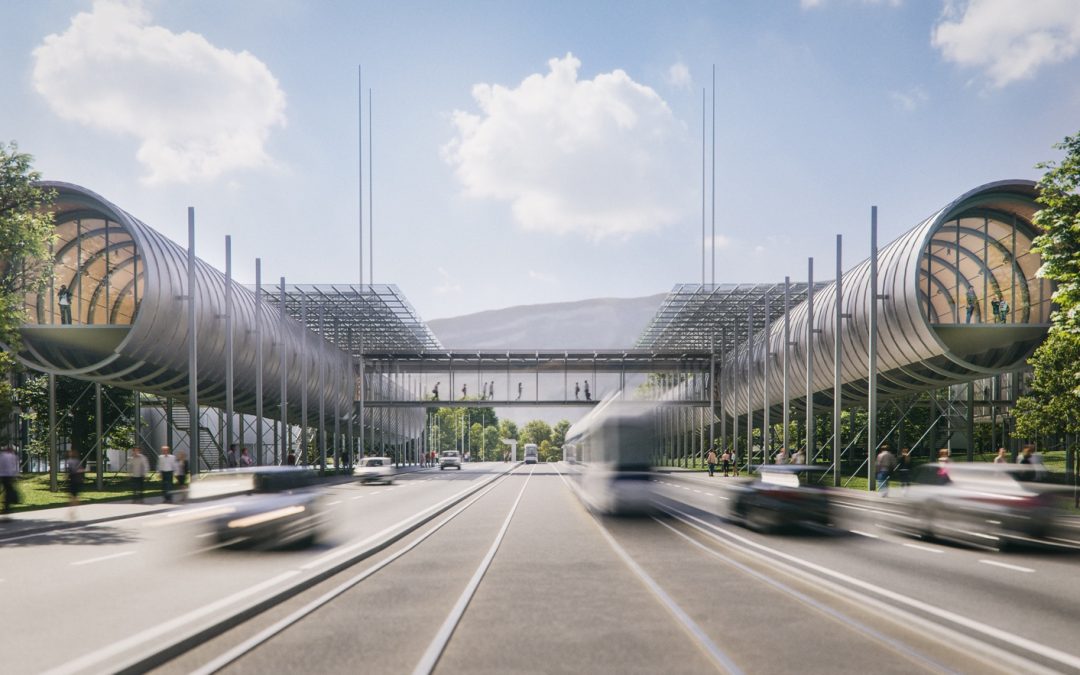As part of its mission to educate and engage the public in science, and to share knowledge and technology with society, CERN is launching the Science Gateway, a new facility for scientific education and outreach. The purpose of the project is to create a hub of scientific education and culture to inspire younger generations with the beauty of science. Aimed at engaging audiences of all ages, the Science Gateway will include inspirational exhibition spaces, laboratories for hands-on scientific experiments for children and students from primary to high-school level, and a large amphitheatre to host science events for experts and non-experts alike.
With a footprint of 7000 square meters, the iconic Science Gateway building will offer a variety of spaces and activities, including exhibitions explaining the secrets of nature, from the very small (elementary particles) to the very large (the structure and evolution of the universe). The exhibitions will also feature CERN’s accelerators, experiments and computing, how scientists use them in their exploration and how CERN technologies benefit society. Hands-on experimentation will be a key ingredient in the Science Gateway’s educational programme, allowing visitors to get first-hand experience of what it’s like to be a scientist. The immersive activities available in the Science Gateway will foster critical thinking, evidence-based assessment and use of the scientific method, important tools in all walks of life.
“The Science Gateway will enable CERN to expand significantly its education and outreach offering for the general public, in particular the younger generations. We will be able to share with everybody the fascination of exploring and learning how matter and the universe work, the advanced technologies we need to develop in order to build our ambitious instruments and their impact on society, and how science can influence our daily life,” says CERN Director General Fabiola Gianotti.“I am deeply grateful to the donors for their crucial support in the fulfilment of this beautiful project.”
The overall cost of the Science Gateway is estimated at 79 million Swiss Francs, entirely funded through donations. As of today, 57 million Swiss Francs have been already secured, allowing construction to start on schedule, thanks in particular to a very generous contribution of 45 million Swiss Francs from the FCA Foundation, which will support the project as it advances through the construction phases. Other donors include a private foundation in Geneva and Loterie Romande, which distributes its profits to public utility projects in various areas including research, culture and social welfare. CERN is looking for additional donations in order to cover the full cost of the project.
John Elkann, Chairman of FCA and the FCA Foundation, said: “The new Science Gateway will satisfy the curiosity of 300,000 visitors every year – including many researchers and students, but also children and their families – providing them with access to tools that will help them understand the world and improve their lives, whatever career paths they eventually choose. At FCA we’re delighted to be supporting this project as part of our social responsibility which also allows us to honour the memory of Sergio Marchionne: in an open and stimulating setting, it will teach us how we can work successfully together, even though we may have diverse cultures and perspectives, to discover the answers to today’s big questions and to those of tomorrow”.
As part of the educational portfolio of the Science Gateway, CERN and FCA Foundation will develop a programme for schools, with the advice of Fondazione Agnelli. The main goal will be to transmit concepts of science and technology in an engaging way, in order to encourage students to pursue careers in STEM (Science, Technology, Engineering and Mathematics). According to the approach of enquiry-based learning, students will be involved in hands-on educational modules and experiments in physics. Special kits will be delivered to classes, containing all necessary materials and instructions to run modules throughout the school year. As a follow-up, classes will be invited to take part in a contest, with the winners awarded a 2-3 day visit to the Science Gateway and CERN. There will be an initial period of experimentation, with a pilot programme in Italy focusing on junior high schools and involving up to 550,000 students. After the pilot, CERN plans to extend this initiative to all its Member States.
The Science Gateway will be hosted in a new, iconic building, designed by world-renowned architects Renzo Piano Building Workshop, on CERN’s Meyrin site adjacent to another of CERN’s iconic buildings, the Globe of Science and Innovation. The vision for the Science Gateway is inspired by the fragmentation and curiosity already intrinsic to the nature of the CERN site and buildings, so it is made up of multiple elements, embedded in a green forest and interconnected by a bridge spanning the main road leading to Geneva. “It’s a place where people will meet,” says Renzo Piano. “Kids, students, adults, teachers and scientists, everybody attracted by the exploration of the Universe, from the infinitely vast to the infinitely small. It is a bridge, in the metaphorical and real sense, and a building fed by the energy of the sun, nestling in the midst of a newly grown forest.”
Also inspired by CERN’s unique facilities, such as the Large Hadron Collider (LHC), the world’s largest particle accelerator, the architecture of the Science Gateway celebrates the inventiveness and creativity that characterise the world of research and engineering. Architectural elements such as tubes that seem to be suspended in space evoke the cutting-edge technology underpinning the most advanced research that is furthering our understanding of the origins of the universe.
A bridge over the Route de Meyrin will dominate the brand-new Esplanade des Particules and symbolise the inseparable link between science and society. Construction is planned to start in 2020 and be completed in 2022.
Architectural vision
Four major elements give shape to the architectural vision.
The “Bridge”. It is the spine along which an ensemble of exhibition and educational spaces develops. The Bridge is conceived as a street raised 6 meters above ground and crossing the Route de Meyrin.
The “Photovoltaic collectors”. Three square photovoltaic panels of 40×40 meters float above three respective pavilions. The central pavilion contains the classrooms. Located above the reception area, this is the place where the main vertical circulation connects the bridge to the ground. The north pavilion is conceived as a very flexible space which can serve as a 900-seat conference room, be split in three independent spaces, or accommodate two smaller venues and a full-height space for science shows. The south pavilion is destined to contain interactive exhibitions.
The “Tunnels”. Two tubes, raised at the bridge level, are designed to accommodate CERN’s permanent and temporary exhibitions. Within the Tunnels, the visitor is immersed in an environment representing the accelerator tunnels 100 meters below ground, where scientific experimentation unveils the deepest secrets of matter.
The “Forest”. Nature is what connects everything together, existing buildings with the new facility. Nature creates a great pedestrian experience. With its 400 trees, the forest wants to say that all exploration is about nature, no matter what the scale is.


